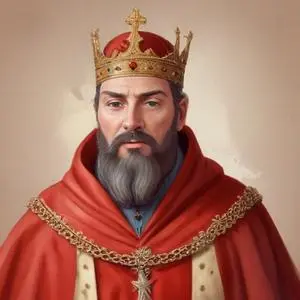
Ruler of Milan who unified the city-states of northern Italy and established a powerful dynasty, known for his military conquests and cultural achievements.
Gian Galeazzo Visconti, the first Duke of Milan, is remembered for his conquests and consolidation of power in northern Italy during the late medieval period, just before the dawn of the Renaissance. He is known for his impressive territorial gains, architectural patronage, and cultural contributions that shaped the city of Milan and its surroundings.
Gian Galeazzo was born on October 16, 1351, to Galeazzo II Visconti and Bianca of Savoy. His father, the Signore of Pavia, instilled in him the importance of power and ambition. Gian Galeazzo's rise to power began in 1385 when he overthrew his uncle, Bernabò, by faking a religious conversion and ambushing him during a procession in Milan. He imprisoned his uncle, who soon died, allegedly poisoned on Gian Galeazzo's orders.
Gian Galeazzo's territorial ambitions drove him to conquer several cities, including Verona, Vicenza, and Padua. He established himself as the Signore of each city, eventually controlling almost the entire Po Valley. In 1393, he granted feudal power to the Confalonieri family in Piacenza, solidifying his grip on the region.
Although he lost Padua in 1390 to Francesco Novello da Carrara, Gian Galeazzo's expansion continued. He received the title of Duke of Milan from Wenceslaus, King of the Romans, in 1395 for 100,000 florins, further legitimizing his rule.
Gian Galeazzo was a patron of the arts and architecture, commissioning several notable projects. He completed the Visconti Castle in Pavia, begun by his father, and contributed to the growth of the Visconti Library, a collection of scientific treatises and richly illuminated manuscripts.
He also supported the construction of the Duomo of Milan, a symbol of the city's grandeur. His architectural patronage not only reflected his wealth and power but also contributed to the cultural and artistic heritage of Milan.
Gian Galeazzo's personal life was marked by turmoil, including the capture of his daughter, Valentina, which led to threats of war with France. He died of fever on September 3, 1402, at the Castello of Melegnano, leaving behind a fragmented territory that his children fought over.
Despite his tumultuous reign, Gian Galeazzo's legacy endures. He played a significant role in shaping the political and cultural landscape of northern Italy, laying the groundwork for the Renaissance. His architectural patronage and cultural contributions continue to inspire and influence art, architecture, and literature to this day.

Born in 1302
A 14th-century Italian nobleman who ruled Milan and expanded its territories through military campaigns and strategic alliances, known for his cunning and diplomatic skills.
Born in 1906
Acclaimed Italian filmmaker renowned for lavish, visually stunning productions that often explored themes of social class, morality, and the human condition. His cinematic masterpieces continue to influence filmmakers today.
Born in 1277
Lord of Milan who ruled with an iron fist, expanding the city's territories through strategic marriages and military conquests. He's known for his brutal suppression of opposition and consolidation of power.
Born in 1452
Ruler of Milan who commissioned Leonardo da Vinci's famous painting, The Last Supper, and was a patron of the arts and architecture.
Born in 1401
The Duke of Milan, a powerful Renaissance leader, expanded his dominion through strategic marriages and military campaigns, fostering a cultural and artistic boom in 15th-century Italy.